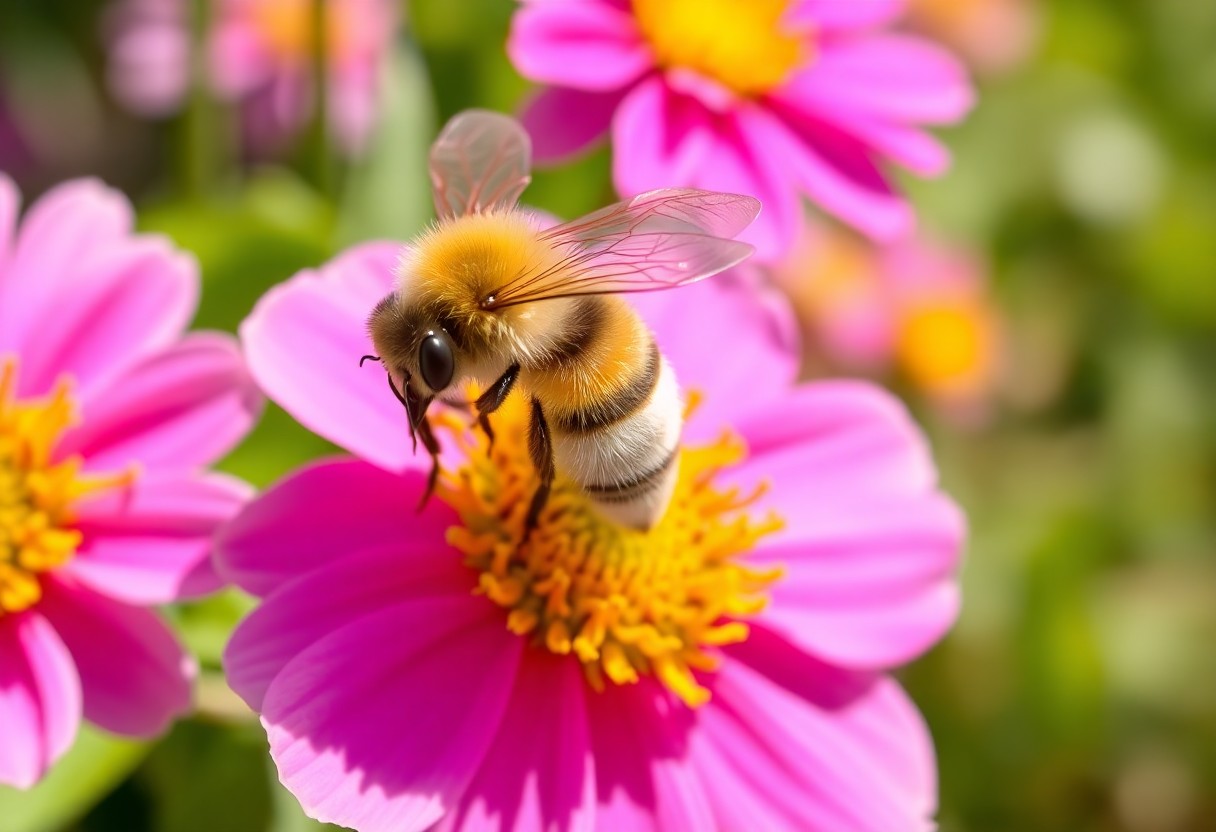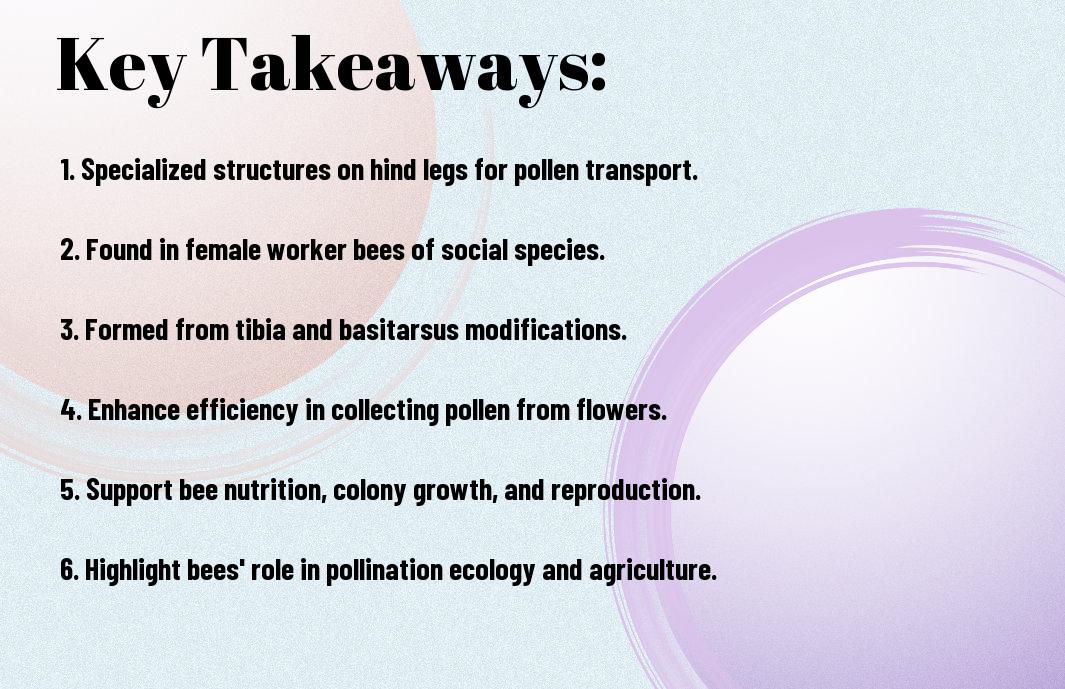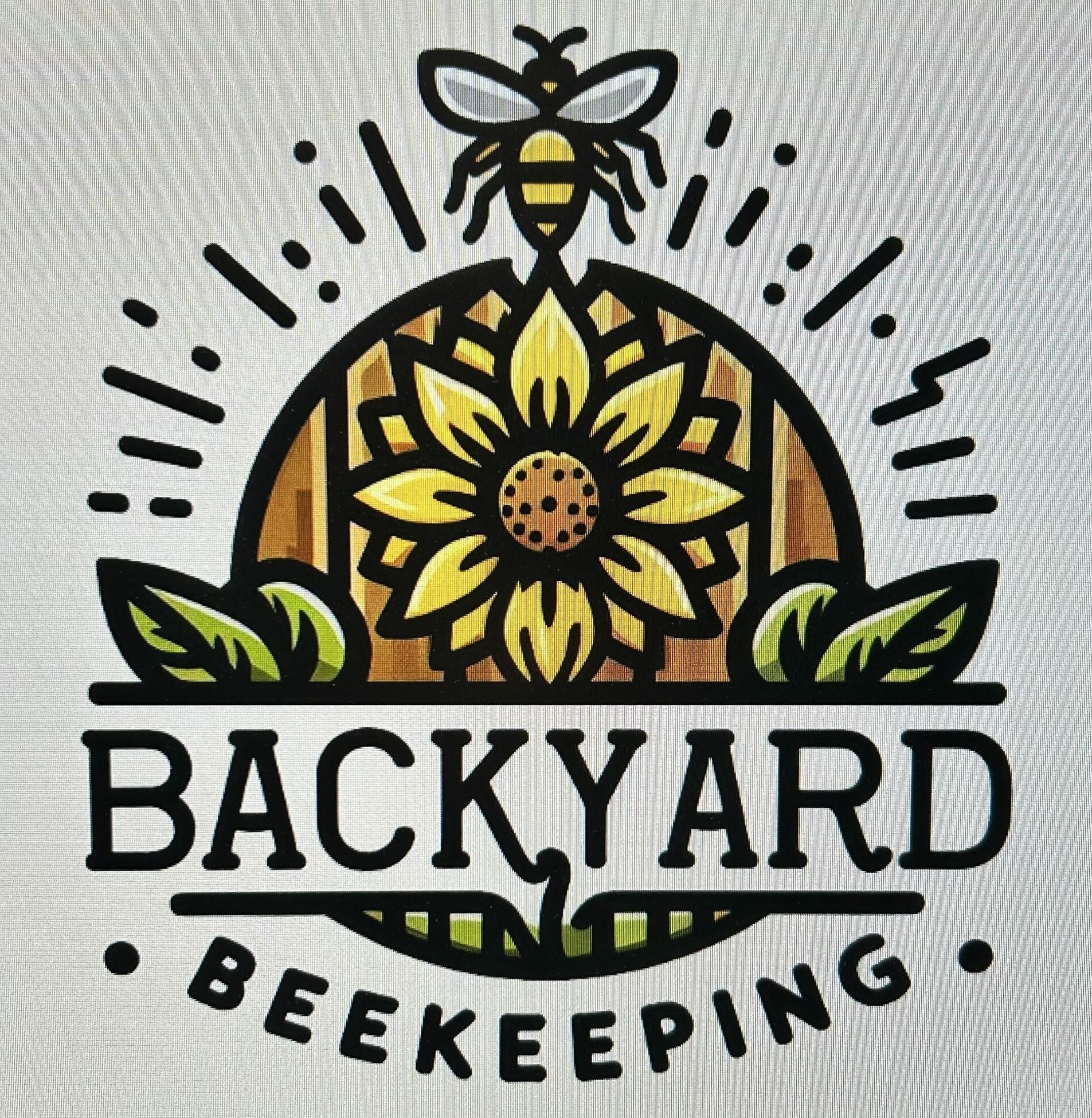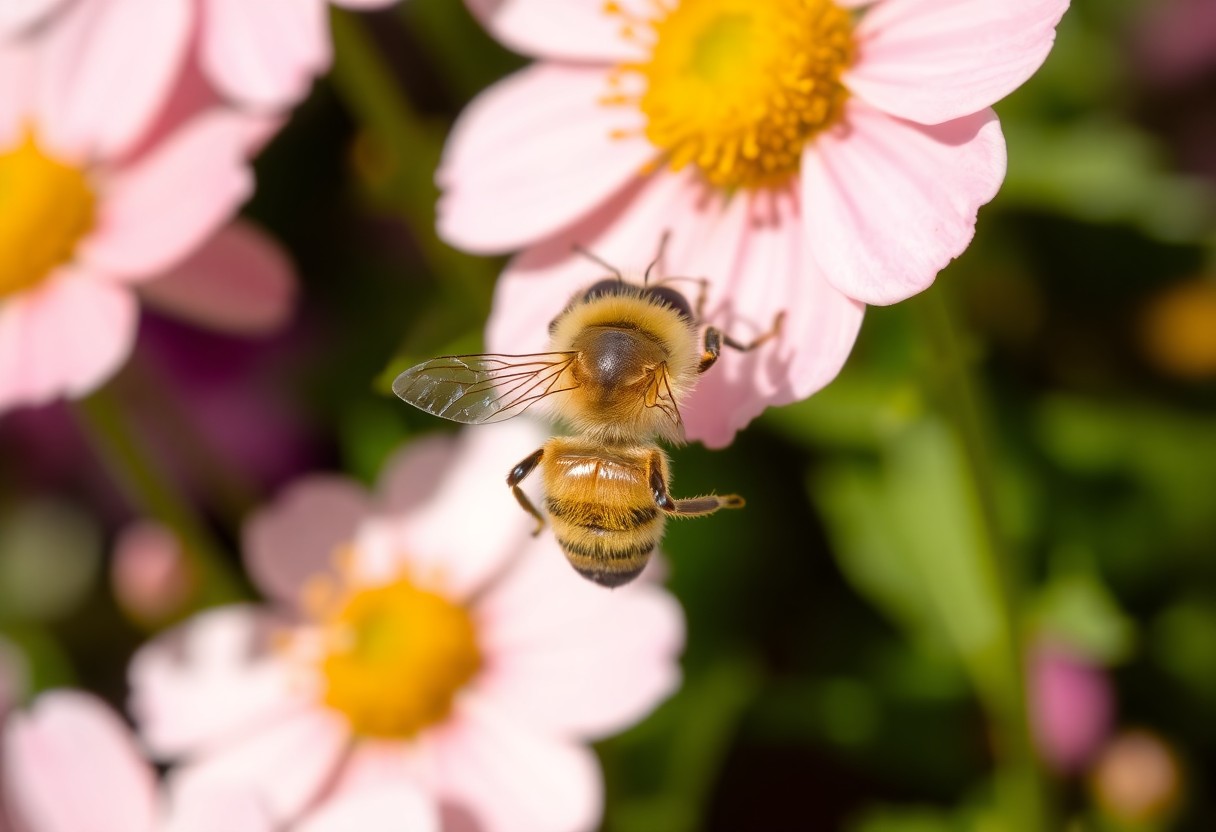Pollen baskets, or corbiculae, play a vital role in the foraging activities of honey bees. As you explore the fascinating world of these industrious insects, you’ll discover how these specialized structures on their hind legs efficiently transport and store pollen collected from flowers. Understanding the significance of pollen baskets enhances your appreciation for honey bees and their imperative contributions to our ecosystems and agriculture. Join us as we investigate into the anatomy, function, and importance of these remarkable adaptations in your local bee populations.

Anatomical Structure of Pollen Baskets
While exploring the fascinating world of honey bees, you will find that their pollen baskets—also known as corbiculae—play a vital role in their foraging behavior and overall colony health. The anatomical structure of these baskets is both specialized and efficient, designed specifically for the task of transporting pollen. Located on the hind legs of female worker bees, these baskets are derived from modifications to the tibia and basitarsus segments, creating concave surfaces that facilitate the collection and retention of pollen grains.
Location and Basic Structure
One of the most notable features of the pollen baskets is their location on the hind legs of female worker bees. This strategic positioning allows bees to gather pollen as they forage, making optimal use of their time and energy. The basic structure consists of a concave depression around which stiff hairs are arranged. These specialized hairs serve to hold and secure the pollen pellets tightly, preventing them from falling off as the bee flies back to the hive.
Morphological Adaptations
The unique morphological adaptations of pollen baskets enable your honey bees to be efficient foragers. Aside from their concave structure, the stiff hairs that encompass the corbicula enhance the basket’s ability to hold pollen. This sturdy design maximizes the amount of pollen that can be collected during each foraging trip, ultimately contributing to the nutritional needs of the colony.
At the same time, the modifications create a balance between flexibility and strength. The ability to expand when loaded with pollen allows bees to carry larger loads, while the rigidity provided by the hair structures ensures that the pollen remains intact and secure during flight. This functional architecture is key to the effectiveness of the bees in pollination and food storage for their larvae.
Comparison with Other Bee Species
Around the world, various species of bees exhibit their own unique adaptations for pollen collection. While the corbiculae in honey bees are well-studied, it’s interesting to see how these structures vary among species. The following table summarizes the differences in pollen basket structures across some common bee species:
Comparison of Pollen Baskets in Different Bee Species
| Bee Species | Pollen Basket Structure |
|---|---|
| Honey Bee (Apis) | Concave tibia with dense hairs around the edge |
| Bumblebee (Bombus) | Prominent corbiculae with less hair density |
| Stingless Bee (Meliponinae) | Less pronounced corbiculae with various hair arrangements |
It’s noteworthy that the overall efficiency of pollen collection can significantly differ based on these structural variations. Different species adapt according to their foraging needs and the floral resources available in their environments. Each of these adaptations plays a significant role in their respective ecological niches, affecting pollination efficiency and, ultimately, the health of their colonies.
It’s necessary to consider these comparative adaptations when thinking about the ecological roles different bees play. Understanding these nuances helps shed light on the unique ways each species interacts with their environment and the floral resources they rely on. Each structure is a product of evolution responding to specific environmental pressures, showcasing the incredible adaptability of bees as a whole.

Components and Features
Clearly, the structure of pollen baskets is a fascinating subject that highlights the incredible adaptations of honey bees. Understanding the components and features of these unique structures can enhance your appreciation of the role they play in the lives of bees and the overall ecosystem. The primary elements of pollen baskets include specific leg segments, specialized hair arrangements, and unique surface characteristics that aid in the collection and transport of pollen.
Tibia and Basitarsus Segments
Among the primary structural components of pollen baskets are the tibia and basitarsus segments, which make up the hind legs of worker bees. These segments are specifically modified to create concave surfaces that form the characteristic shape of the pollen basket, also known as corbicula. The anatomical design of these segments allows for an efficient collection of pollen, which is vital for feeding the colony and supporting larval development.
In honey bees, these segments have specific adaptations that enhance their function. The tibia and basitarsus work together to support the weight and volume of pollen that the bee gathers, effectively allowing it to transport substantial amounts back to the hive. This modification is not just a mere structural change; it plays a significant role in the bee’s efficiency during foraging expeditions.
Specialized Hair Arrangements
Hair adaptations found along the edges of pollen baskets are pivotal for effective pollen collection. Hair structures, which are stiff and closely spaced, create friction that helps secure pollen grains as bees gather their harvest from flowers. These specialized hair arrangements ensure that the pollen remains firmly packed into the basket, preventing loss as the bee navigates back to the hive.
At the same time, these hairs also support the bee’s foraging efficiency. The design of the corbicula allows bees to clasp onto pollen more effectively, further enhancing their ability to transport substantial amounts back to the hive. This combination of functional morphology offers an evolutionary advantage, as it enables bees to gather the necessary resources for colony sustenance.
Surface Characteristics
Any discussion of pollen baskets must include the unique surface characteristics that set them apart. The inner surfaces of pollen baskets are often textured, promoting better adhesion of pollen grains. This texture, combined with the previously mentioned hair structures, creates a highly effective mechanism for securing and transporting pollen. It is an exquisite illustration of nature’s ability to optimize form and function.
Further investigation into the surface characteristics reveals that the texture may also play a role in minimizing the loss of pollen during flight. Variations in the surface topography can impact how well pollen sticks, which means that a well-formed basket can significantly enhance a bee’s foraging efficiency. Understanding these details allows you to appreciate the intricate design of these pollen baskets as extraordinary adaptations important for honey bee survival and their role in pollination.
Pollen Collection Mechanism
To understand how honey bees effectively gather pollen, it’s crucial to investigate into their gathering process. When you observe a bee foraging, it actively seeks out flowers that offer abundant pollen. As the bee lands on a flower, it uses its specialized mouthparts and legs to access the pollen. The bee delicately brushes against the flower’s anthers, which dislodge pollen grains that adhere to its body. This first stage is vital, as it sets the foundation for successful pollen transport back to the hive.
To optimize their efficiency, honey bees use their legs to collect the dislodged pollen. Each hind leg features a unique structure known as a pollen basket or corbicula, specifically designed to hold the gathered pollen. As a bee moves from flower to flower, it accumulates these pollen pellets and compresses them into the concave area of the basket, preparing for the journey home.
Pollen Compression Methods
Collection of pollen in a honey bee’s pollen basket is not merely a matter of gathering loose grains; it involves sophisticated compression methods. The bee skillfully manipulates the collected pollen using its legs and mandibles, forming spherical pellets that fit snugly into the basket. By exerting pressure and rolling the pollen grains, you can observe how bees create compact masses that maximize storage efficiency.
Further attention to the compression methods reveals that honey bees display remarkable dexterity and coordination. This process ensures that the pollen pellets remain intact and secure during flight, allowing the bee to transport substantial amounts of food back to the hive without losing any vital resources. Each trip is a demonstration of nature’s precision in resource utilization.
Role of Specialized Hairs
With respect to their anatomy, specialized hairs play a significant role in the pollen collection mechanism of honey bees. These hairs, known as “pollen brushes,” are strategically positioned on the legs and help trap and retain pollen grains as the bee moves among flowers. When you look closely at a foraging bee, you can see how these stout hairs act as a net, maximizing the amount of pollen collected from each visit.
Pollen brushes not only enhance collection efficiency but also aid in the transfer of pollen to the pollen baskets. When you observe a bee foraging, note how it uses its forelegs to sweep and pack pollen into the hind leg baskets. This efficient layering system enables the bee to transport significant quantities of pollen, which is crucial for the sustenance of the hive and the development of larvae.
Function and Importance
Once again, the fascinating design of pollen baskets plays a fundamental role in the life of honey bees. These specialized structures allow bees to efficiently gather and transport pollen, which is vital for the survival and functioning of the colony. By harnessing the power of their pollen baskets, bees ensure that their colonies have consistent access to the nutrition required to thrive and grow.
Colony Nutrition
Around the hive, the collection of pollen is central to providing the necessary nutrients for your bees. Pollen is rich in proteins, lipids, vitamins, and minerals, which are imperative for the bees’ health and productivity. Worker bees utilize their pollen baskets to collect pollen pellets from flowers, transporting them back to the hive where they are used to feed the brood and sustain adult bees alike. This nutrition is particularly important during the spring and summer months when the colony is expanding and requires more resources.
Brood Development
Behind the scenes in the hive, your bees rely on the fresh pollen stored in the pollen baskets to support brood development. Pollen is not just food; it is foundational for the growth of larval bees, as it provides the necessary protein and nutrients for their development. Worker bees mix the collected pollen with honey and nectar to create a nutrient-rich food called “bee bread,” which is then fed to the larvae, ensuring they receive optimal nutrition to mature into healthy adult bees.
For instance, the growth rate and overall health of the brood are directly correlated to the quality and quantity of the pollen brought into the hive. Without sufficient pollen resources, you may notice stunted larval development and increased mortality rates among the young bees, which ultimately affects the colony’s ability to function and thrive.
Storage Methods
Alongside their role in nutrition, the pollen baskets also dictate how your bees store pollen effectively. Upon returning to the hive, bees deposit the pollen into specialized cells before sealing them. This not only preserves the efficacy of the pollen but also ensures that it remains accessible throughout the year, particularly during times when flowers may be scarce. Proper storage methods are imperative for maintaining a continuous food supply for the colony, particularly in preparation for winter or drought conditions.
Considering the importance of these storage techniques, it becomes clear that bees have developed sophisticated behaviors to maximize the longevity and viability of their pollen supply. By utilizing their pollen baskets effectively, your bees can mitigate the risks associated with seasonal variations in food availability, ensuring the survival and health of the entire colony.
Behavioral Aspects
Now, understanding the behavioral aspects of honey bee pollen baskets is vital for comprehending how these remarkable insects contribute to their ecosystem. The foraging patterns exhibited by bees play a significant role in the efficiency of pollen collection, impacting not only their own nutrition but also the pollination services they provide to flowers. When you observe a foraging honey bee, you will notice a systematic approach: they tend to visit a wide range of flowers, collecting pollen from multiple sources. This behavior enhances genetic diversity in plants and maximizes the nutritional intake for the bee colony.
Foraging Patterns
Against common belief, honey bees do not randomly flit from flower to flower. Instead, they often adopt a methodical strategy based on flower availability and pollen quality. Research indicates that bees are particularly adept at recognizing the floral preferences of their colonies, often visiting flowers that yield higher pollen rewards. They communicate their findings to other bees through a dance, effectively coordinating foraging efforts and optimizing the collection process. By focusing on floral diversity, you can help support these natural foraging behaviors, ensuring your garden provides a favorable environment for bees.
Loading Techniques
Any effective pollen collection technique involves a careful strategy to ensure efficiency. Honey bees utilize their hind legs and specialized pollen baskets to pack pollen into manageable pellets that can be transported back to the hive. This is no simple task; it requires skill and coordination as they groom their bodies with their legs, transferring pollen from their bodies into the concave structures of the pollen baskets. You might observe this fascinating process in action as bees meticulously adjust and mold the pollen balls before taking flight.
In fact, the loading techniques of honey bees are more intricate than they may first appear. During the foraging process, bees will spend considerable time transferring pollen to their hind legs, often using their forelegs to pack and compress the pellets tightly into the corbicula. This not only maximizes the amount of pollen they can carry but also helps to prevent it from falling off during transit. The evolution of these techniques showcases the bees’ adaptability and ingenuity in their quest for resources.
Transport Efficiency
Across the journey back to the hive, honey bees exhibit remarkable transport efficiency thanks to their streamlined loading techniques. They optimize their flight path by minimizing distances and using environmental cues to navigate effectively. This ability to recall and recognize floral sources significantly enhances your local bee populations’ foraging success. Additionally, the gathering of pollen into well-formed pellets allows bees to carry larger amounts without compromising their flight ability.
Further enhancing transport efficiency, honey bees can adjust their load based on the distance to the hive and their immediate needs. When foraging close to their nest, they might accumulate more pollen, while those further away balance their loads to maintain agility in flight. This adaptability to their environment underlines the importance of providing a diverse range of flowering plants, as it not only supports their nutritional needs but also improves the overall health and productivity of the hive. By understanding these behaviors, you can play a vital role in fostering a welcoming habitat for honey bees, ultimately benefiting your garden and local ecosystem.
Ecological Significance
Unlike many other insects, honey bees play a vital role in the health of ecosystems through their impressive pollen baskets. When you observe these remarkable structures on the hind legs of female worker bees, you witness an crucial component of their foraging technique that significantly impacts the environment. The design of the pollen baskets allows bees to collect large amounts of pollen efficiently, ensuring that they can sustain not only their colonies but also the plants they interact with in their quest for food.
Role in Pollination
Pollination is a critical process that enables the reproduction of flowering plants, and honey bees are among the most effective pollinators in the natural world. As you watch these bees travel from flower to flower, their pollen baskets gather pollen grains, which they inadvertently transfer to other blooms. This action facilitates cross-pollination, enhancing genetic diversity and improving the health of various plant populations.
Your understanding of the importance of honey bees can deepen when you recognize that the success of many crops is directly linked to their pollination activities. In fact, honey bees contribute to the pollination of over 80% of flowering plants, including a significant number of fruits and vegetables that are staples in your diet. Without their diligent work, many of these plants might fail to produce, underscoring the bees’ indispensable role in the ecosystem.
Impact on Plant Reproduction
Among the many benefits provided by honey bees, their ability to enhance plant reproduction stands out. The annual production of numerous fruits, seeds, and vegetables is tightly linked to these insects’ pollination efforts, directly affecting food production sustainability. As you examine how bees collect and distribute pollen from one bloom to another, you witness an intricate symbiotic relationship in action, where both the bees and the plants thrive.
Impact on plant reproduction goes beyond mere aesthetics; it is fundamental to the survival of many species. By facilitating cross-pollination, honey bees ensure that plants produce viable seeds, which are crucial for the next generation of flora. This cycle not only sustains existing plant species but also contributes to overall biodiversity within your local ecosystem.
Agricultural Importance
Ecological studies have consistently shown that the health of agricultural systems is closely intertwined with the pollination services provided by honey bees. As a farmer or someone interested in agriculture, you must recognize that these little insects contribute to about one-third of the food your community consumes. Their efficient pollen collection directly translates to higher yields and more robust harvests, making them a natural ally in food production.
This profound relationship between honey bees and agriculture highlights the pressing need to protect their habitats and promote their health. Strategies such as planting diverse crops, reducing pesticide use, and maintaining healthy environments for bee populations will ensure that you not only support bee health but also enhance your agricultural productivity for years to come.
Summing Up
Hence, understanding the role of honey bee pollen baskets is pivotal to appreciating the intricate behaviors and adaptations of these important pollinators. When you observe these remarkable structures, you gain insight into how honey bees efficiently gather and transport pollen, which is vital for the nourishment of their colonies. This process not only facilitates the survival and development of bee larvae but also has significant implications for agricultural productivity and biodiversity in your environment.
Moreover, as you learn about pollen baskets, you become more aware of the interconnectedness between bees and the plant species they pollinate. By valuing the contributions that honey bees make through their foraging activities, you can appreciate the pivotal role they play in maintaining healthy ecosystems. Your understanding of these adaptations can inspire action towards preserving bee habitats and promoting practices that support their populations, ultimately benefiting both nature and agricultural systems.
FAQ
Q: What are honey bee pollen baskets and how do they function?
A: Honey bee pollen baskets, also known as corbiculae, are specially adapted structures located on the hind legs of female worker bees. They are designed to transport and store pollen collected from flowers while foraging. The pollen basket features concave depressions surrounded by stiff hairs, which help to securely hold and retain pollen pellets during the bee’s flight back to the hive.
Q: Why are pollen baskets important for honey bee colonies?
A: Pollen baskets play a vital role in the nutrition and overall health of honey bee colonies. The pollen collected and stored in these baskets is a primary source of protein and vital nutrients for the bees, especially for feeding larvae. The efficient gathering of pollen supports colony growth, development, and reproduction, making pollen baskets a key adaptation for social bee species.
Q: How do honey bees collect pollen using their pollen baskets?
A: As honey bees forage, they visit various flowers and collect pollen with their forelegs and mouthparts. The collected pollen is then packed into the concave surfaces of their pollen baskets. The stiff hairs around the edges of the baskets help to secure the pollen pellets. Once the baskets are filled, bees return to the hive, where they can unload the pollen for storage or for feeding the colony.
Q: Are pollen baskets found in all bee species?
A: No, pollen baskets are primarily found in certain social bee species, including honey bees, bumblebees, and stingless bees. Solitary bees and other bee species may utilize different methods for pollen collection and transport, and they do not have the specialized structure of pollen baskets like those found in social bees.
Q: How do pollen baskets affect pollination ecology?
A: Pollen baskets significantly influence pollination ecology by enabling bees to efficiently collect pollen from a variety of floral sources. This activity not only supports the nutritional needs of the bee colonies but also facilitates the transfer of pollen between flowers, promoting plant reproduction. The interactions between bees and flowers exemplify the vital role of bees as pollinators in both natural ecosystems and agricultural settings.

